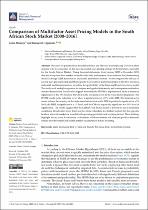| dc.description.abstract | first_pagesettingsOrder Article Reprints
Open AccessFeature PaperArticle
Comparison of Multifactor Asset Pricing Models in the South African Stock Market [2000–2016]
by Lenia Mukoyi 1 andKanayo K. Ogujiuba 2,*ORCID
1
School of Business and Finance, University of the Western Cape, Belville, Cape Town 7535, Western Cape, South Africa
2
School of Development Studies, University of Mpumalanga, Nelspruit 1200, Mpumalanga, South Africa
*
Author to whom correspondence should be addressed.
J. Risk Financial Manag. 2023, 16(1), 4; https://doi.org/10.3390/jrfm16010004
Received: 2 October 2022 / Revised: 23 November 2022 / Accepted: 25 November 2022 / Published: 22 December 2022
Download Versions Notes
Abstract
The quest for parsimonious models has been a key objective in asset pricing. However, there appears to be no consensus on the most successful asset pricing strategy in the literature, especially for the South African Market. Using financial statements from January 2000 to December 2015, this article explores how market anomalies affect the performance of securities in the Johannesburg Stock Exchange’s (JSE’s) resources, industrial, and finance sectors. We investigated the efficacy of several asset pricing models and their capacity to account for market anomalies in the JSE’s resources, industrial, and financial sectors, as well as the applicability of the Fama and French five-factor model. The study used multiple regression techniques and applied stationarity and cointegration methods to ensure robust results. Results also suggest that when the FF5FM is implemented, there is statistical significance at the 10% level for the CMA in the resources sector as the value factor disappears. The FF5FM results in the industrial sector show a significance level of 5% in the SMB. The financial sector seems to have the majority of the style-based risk factors as the SMB is positively significant at a 5% level, the HML is significant at a 1% level, and the CMA is negatively significant at a 10% level of significance. | en_US |

